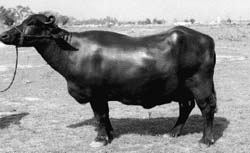Dolly s dark cousin
 after Dolly, the world's first adult cloned mammal, it is the turn of the Indian buffalo. Scientists at the National Diary Research Institute ( ndri ), Karnal have claimed to have developed a procedure for producing several identical buffalo calves from a single embryo. They are in the final stages of producing the world's first buffalo clone and have published a report on their pioneering efforts in the Indian Journal of Experimental Biology .
after Dolly, the world's first adult cloned mammal, it is the turn of the Indian buffalo. Scientists at the National Diary Research Institute ( ndri ), Karnal have claimed to have developed a procedure for producing several identical buffalo calves from a single embryo. They are in the final stages of producing the world's first buffalo clone and have published a report on their pioneering efforts in the Indian Journal of Experimental Biology .
The scientists are using the nuclear transfer technique where an egg cell is taken out of the buffalo's ovary and its nucleus is replaced by a cell from another embryo. The method can be repeated with every cell in the donor embryo to produce several identical clones for implantation in surrogate mothers. Scientists at ndri made a cut in jelly-like covering of a mature egg and pressed it from one side to squeeze out the nucleus. A donor buffalo embryo of higher breed was isolated and then transferred to a culture medium. Individual cells from it were transferred gently into the enucleated egg.
The report said that the quick transfer of cells from the original embryo was critical in obtaining a large number of clones. Short electric pulses helped fusion of the two cells after transfer. The new cell complex is then allowed to grow up to a 32-cell stage after which it is ready to be placed in a surrogate animal.
Theoretically, each of the 64 cells of the donor embryo can be transferred into 64 enucleated egg cells to produce 64 embryos. "However, in practice, 12 to 16 embryos were transferred with success,' said M L Madan, who was part of the three-member ndri team at the Indian Council of Agricultural Research. The other two members are Suresh Sanghla and R S Manik.
The scientists say that till now cloning has been done on rabbits, mice, sheep, goat, cattle and pigs. This is for the first time it has been tried on the buffalo. "As India has the best buffaloes in the world, the nuclear transfer technique may make it possible to clone and multiply calves from a single embryo taken from a buffalo with superior traits,' says the report. Although the better varieties of cows are found in other parts of the world, India has the best breeds of buffaloes, says Madan. The Murrah and the Zaffarabadi breeds produce up to 30 litres of milk per day.
The technique used at ndri is however different from the one which was used to clone Dolly. At the Roslin Institute at Edinburgh, uk , where Dolly was cloned, the researchers used the somatic cells from the mammary glands for cloning, whereas the Indian scientists have used the gametic cells, says Madan.
The project in Karnal was started in 1986 and so far three phases have been successfully completed. The first three stages involved embryo transfer, in-vitro fertilisation and cloning of the embryo. Now the research has reached the crucial stage of transfer of the embryo. "At each stage of transfer, the success rate reduce phenomenally and the research has now reached a critical stage,' says Madan.
The scientists produced nearly 100 cloned embryos. Unless frozen, these embryos do not last more than a couple of days. Admitting that they were still gathering the necessary facilities to carry out such "complicated' transfer procedures, he said. "You cannot beat nature,' says Madan. Cloned embryos are very fragile compared to the naturally obtained embryos and no freezing technology has been developed so far to preserve them, says Madan.
The process of cloning has been in progress for a long time. In 1952, researchers in Pennsylvania, usa, cloned a live frog from an embryonic cell. In 1980, biologists in Philadelphia raised tadpoles but half way through the metamorphosis died. And then came Dolly.
The process of cloning has been a controversial issue. The debate peaked when Dolly was "manufactured'. The possibility of the misuse of this biotechnological advancement has left many sceptical about the "good' behind this new technique.
However, Madan says that cloning has its own advantages. He says cloning would help raise the volume of milk production per animal. India is set to replace the us as the largest producer of milk in the world, he said. India has 78 million buffaloes and this technique might produce high-producing elite males that will improve the quality of the stock.
